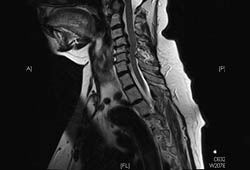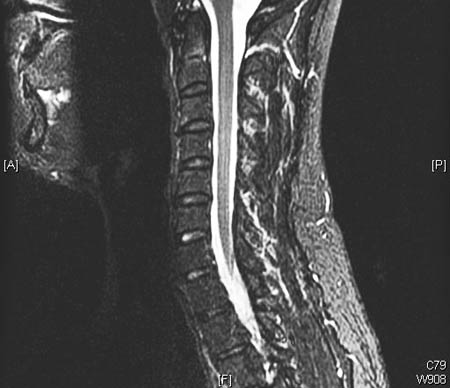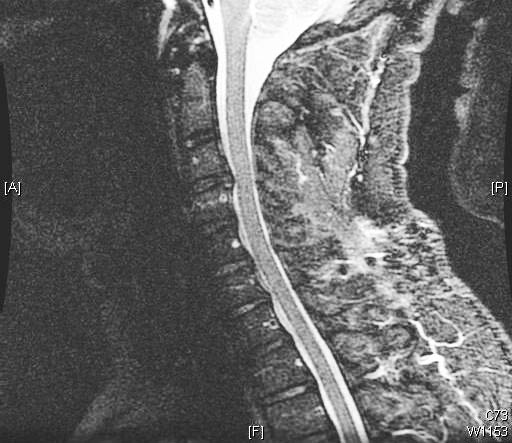Resumo
Definição
História e exame físico
Principais fatores diagnósticos
- presença de fatores de risco
- início espontâneo de dor cervical
- dor e espasmo muscular cervical
- cefaleias ou dor occipital
- fraqueza ou dormência
- presença de dor irradiada no ombro e no membro superior
- alterações de reflexo
- fraqueza no braço proximal
- fraqueza na mão distal
- ataxia de marcha
Outros fatores diagnósticos
- espasmo muscular cervical
- diminuição da amplitude de movimento cervical
- alterações sensoriais
Fatores de risco
- idade >50 anos
- trauma cranioencefálico ou cervical
- cirurgia prévia da coluna cervical
- predisposição genética
- tabagismo
- participação em esportes de contato
- profissão
- suporte de carga pesada
Investigações diagnósticas
Primeiras investigações a serem solicitadas
- RNM cervical
- radiografia cervical
Investigações a serem consideradas
- tomografia computadorizada (TC) cervical
- mielografia de TC cervical
- eletromiografia cervical/dos membros superiores ou velocidade de condução nervosa
- bloqueio da raiz nervosa cervical
Algoritmo de tratamento
dor cervical axial
radiculopatia espondilótica cervical (REC)
mielopatia cervical degenerativa (MCD)
Colaboradores
Autores
Dennis A. Turner, MA, MD

Professor
Neurosurgery, Neurobiology, and Biomedical Engineering
Duke University Medical Center
Durham
NC
Declarações
DAT is an author of a reference cited in this topic.
Revisores
Richard G. Chang, MD, MPH, FAAPMR
Associate Program Director
Sports Fellowship
Assistant Professor
Icahn School of Medicine
Mount Sinai
NY
Declarações
RGC is a member of the AAPM&R Health Policy & Legislative Committee, and receives reimbursement for travel to in person once a year Capitol Hill meeting and annual AMA State Advocacy Summit conference.
Créditos aos pareceristas
Os tópicos do BMJ Best Practice são constantemente atualizados, seguindo os desenvolvimentos das evidências e das diretrizes. Os pareceristas aqui listados revisaram o conteúdo pelo menos uma vez durante a história do tópico.
Declarações
As afiliações e declarações dos pareceristas referem--se ao momento da revisão.
Referências
Principais artigos
Bono CM, Ghiselli G, Gilbert TJ, et al; North American Spine Society. An evidence-based clinical guideline for the diagnosis and treatment of cervical radiculopathy from degenerative disorders. Spine J. 2011 Jan;11(1):64-72. Resumo
Joint Section on Disorders of the Spine and Peripheral Nerves of the American Association of Neurological Surgeons and Congress of Neurological Surgeons. Guidelines for the surgical management of cervical degenerative disease. 2009 [internet publication].Texto completo
American College of Radiology. ACR appropriateness criteria: cervical neck pain or cervical radiculopathy. 2024 [internet publication].Texto completo
Nikolaidis I, Fouyas IP, Sandercock PA, et al. Surgery for cervical radiculopathy or myelopathy. Cochrane Database Syst Rev. 2010 Jan 20;(1):CD001466.Texto completo Resumo
Artigos de referência
Uma lista completa das fontes referenciadas neste tópico está disponível para os usuários com acesso total ao BMJ Best Practice.

Diagnósticos diferenciais
- Lesão em chicote (tensão miofascial cervical)
- Hérnia de disco aguda
- Neoplasia metastática
Mais Diagnósticos diferenciaisDiretrizes
- ACR appropriateness criteria: cervical pain or cervical radiculopathy
- A clinical practice guideline for the management of patients with degenerative cervical myelopathy: recommendations for patients with mild, moderate, and severe disease and nonmyelopathic patients with evidence of cord compression
Mais DiretrizesFolhetos informativos para os pacientes
Dorsalgia: perguntas a fazer ao seu médico
Dorsalgia (coluna lombar)
Mais Folhetos informativos para os pacientesConectar-se ou assinar para acessar todo o BMJ Best Practice
O uso deste conteúdo está sujeito ao nosso aviso legal

